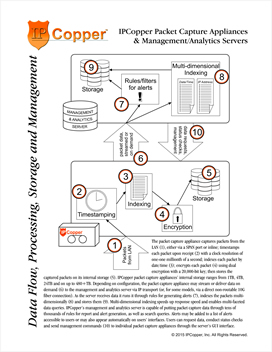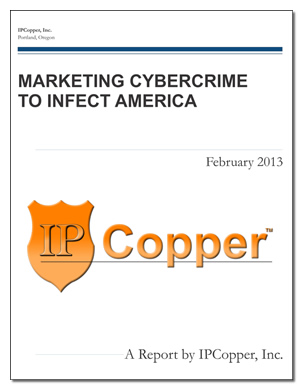Storage Capacity
Resources
When choosing a packet capture appliance, an important consideration is the time span of network activity that you would like to be able to store. When using captured network data to troubleshoot network equipment / applications or do forensic analysis of network incidents, it is critical to have available data from the entire timespan of the event under investigation. Further, signature development time for new viruses, malware and APTs discovered in the wild is generally several months or longer and it may take months before a breach or other network event is discovered. For these reasons, we recommend planning for enough capacity to retain network activity records for at least 6-12 months.
Standard IPCopper packet capture appliances come in capacities ranging form 1 TB to 48 TB. Custom IPCopper configurations allow stacking to achieve capacities of up to 1,152 TB.
Memory Capacity |
Peak Capture Speed |
Min. Sustained Capture Speed |
Type |
Min. Sustained Packet Rate (packets/second) |
|
USC1030 |
1 TB |
1 Gbps |
400 Mbps |
forensic |
150,000 |
USC4060 |
4 TB |
1 Gbps |
400 Mbps |
continuous-loop |
165,000 |
USC6042 |
4 TB |
1 Gbps |
400 Mbps |
continuous-loop |
100,000 |
USC10G3 |
24 TB |
10 Gbps |
5 Gbps |
continuous-loop |
6,000,000 |
USC10G4 |
24 TB |
10 Gbps |
5 Gbps |
continuous-loop |
6,000,000 |
USC10M2 |
48 TB |
10 Gbps |
5 Gbps |
continuous-loop |
6,000,000 |
USC10M3 |
48 TB |
10 Gbps |
8 Gbps |
continuous-loop |
6,000,000 |
Estimating packet capture capacity needs
Please see the table below for daily storage capacity utilization for different bandwidth usages. For ease of computation, we assumed assymmetrical usage (the connection has substantially more traffic in one direction than the other).
Avg. Max. Sustained Bandwidth Utilization |
Usage Pattern |
Per-Day Capacity Usage |
100 Mbps |
24-hr |
1 TB |
100 Mbps |
8-hr |
0.35 TB |
40 Mbps |
24-hr |
0.4 TB |
40 Mbps |
8-hr |
0.125 TB |
20 Mbps |
24-hr |
0.2 TB |
20 Mbps |
8-hr |
0.07 TB |
Some industries, such as hospitals and medical offices that constantly deal with large data files, necessarily have higher bandwidth utilization than others. For example, a hospital data center may peak at around 1 Gbps (~5 TB per day usage) whereas a large office may use up to 25 Mbps sustained (~250 GB per day usage).
The overhead of IPCopper appliances ranges from 1% to 10%, depending on the size of the packets. If your average packet size is around 1000 bytes, the overhead would be, conservatively, 3%. The larger the packet, the lower the overhead percentage. For average traffic, an overhead of 5% is a good number to use in your calculations.
To aid you in estimating your office's usage needs, the table below gives the approximate size of files that commonly traverse data networks.
Type of Content |
Average Size of File |
Quantity That Would Fit on 1 TB |
MP3 song, 128kbps stereo |
3 MB |
333,000 |
1 min of CD quality audio, 44Khz uncompressed 16bit |
10 MB |
100,000 |
Average plain text email, no attachments |
2000 bytes |
500,000,000 |
Average HTML email, no attachments |
5000 bytes |
200,000,000 |
one-page word document, no graphics |
10 kb |
100,000,000 |
web quality photograph, jpg format |
100 kb |
10,000,000 |
high resolution digital photograph, jpg format |
1.5 MB |
666,000 |
dvd-quality full length movie |
4.7 GB |
212 |
1 CD |
650-800 MB |
1250-1538 |
one minute of internet radio |
480 kb |
2,083,000 |
one minute VoIP telephone call, G711 codec, high quality |
600 kb |
1,667,000 |
one-page fax, high quality |
100 kb |
10,000,000 |

Managing Packet Capture on Networks with High Utilization
Packet capture on networks with high bandwidth utilization generate large amounts of data over a short period of time, requiring robust strategies to both manage, retain and analyze network data. IPCopper's management and analytics servers provide a centralized location from which to manage multiple IPCopper packet capture appliances, aggregate PCAP data and analyze the captured network data with indexing, search and other capabilities, including a high-performance IDS engine with IP and signature based rules for alerts and reporting. With IPCopper's analytics server, network operators can get a handle on managing tens and hundreds of terabytes of data, with the ability to examine the data both in aggregate and at the individual packet and session level.
The serverís core functions include packet capture appliance management; data acquisition and aggregation; and search. Its searching capabilities encompass both simple, one-dimensional searches and multi-dimensional searches, including searches by IP and MAC address with differentiators for source versus destination references; port; date and time ranges; signature matches, either by packet or TCP/IP session; HTTP header fields (file name, host, user, agent, etc); protocol; and other parameters.
IPCopper's analytics servers' native storage may be increased with the addition of storage modules, for total storage of 480+ TB.

